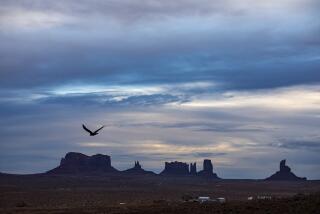Even Holy Water Yields to Drought
- Share via
GOLDEN, Colo. — The planters at the grotto at the Mother Cabrini Shrine have no flowers, just dirt. The nuns are limited to seven-minute showers. They go to a coin laundry to clean their linens.
And the shrine’s main spring -- considered holy by the faithful, who believe that its water can heal -- is being supplemented with city water brought in by truck.
Because of the worst drought in a century, conserving water has become common throughout the West.
But at the shrine, it takes on a loftier purpose. Every year, about 150,000 people from around the world visit, many just for the water.
“Because so many people come up to pray for peace and are looking for a cure for their body, it helps them to be able to take some water home with them,” said the shrine’s director, Sister Bernadette Casciano of the Missionary Sisters of the Sacred Heart of Jesus.
Mother Frances Cabrini, the United States’ first saint, discovered the shrine’s first spring -- the one now regarded as holy -- in 1912 when she bought the property to serve as a summer camp for an orphanage.
Cabrini, a shrewd businesswoman who founded more than 60 schools, orphanages and hospitals, got the property at a bargain because no one believed that water would be found there.
But at a picnic with some girls and nuns, Cabrini is said to have touched a rock with her cane and asked someone to lift it, thus uncovering the spring.
For 90 years, three springs have provided water at the shrine, which features a retreat and 22-foot hilltop statue of Jesus overlooking Denver, 20 miles away.
The nuns typically rely on two of the three springs for indoor use and irrigation.
This year, though, drought has slowed the flow at all three springs. And all three have been pressed into service for everyday uses.
Small paper cups are provided to pilgrims who want to help themselves to the holy water. A sign asks people to limit themselves to one quart each.
Pilgrims must use portable toilets, and the only decorative flowers nearby are purple plastic ones mixed with real marigolds.
The nuns also serve large retreat groups with paper plates.
The spring water has never been declared holy by the Roman Catholic Church, but that did not stop Le Hoan, a Vietnamese hairdresser who lives in Denver from visiting the shrine to pray for her 4-year-old daughter, who was about to undergo kidney surgery.
Hoan has brought water home to her daughter from previous visits.
“I believe in her,” Hoan said of Cabrini.
“That’s why I come here.”
Lucia Aguilera of Denver took a bottle to bless her home. She went picnicking with her husband and two children next to the grotto before climbing 373 stairs to the statue.
The nuns hope to raise $250,000 to allow the shrine to tap into city water for everyday uses so that the spring can provide water just for pilgrims.
Casciano said conserving water fits in with her order’s philosophy of being good stewards of the earth.
But she believes that more people will have to learn to view every last drop of their water as precious too.
“We’re just paving the way,” she said.
More to Read
Sign up for Essential California
The most important California stories and recommendations in your inbox every morning.
You may occasionally receive promotional content from the Los Angeles Times.













